Product Type: In-Furrow Options
Y-NOT SPLIT-IT®
In-Furrow Fertilizer Fitting for the Rebounder
About the Y-Not
As the Rebounder places the seeds in the bottom of the furrow, the Y-Not places fertilizer halfway up the sidewall.
The Y-Not allows fertilizer to soak into the sidewall and keeps it from going directly onto the seed. It is insurance against fertilizer burn.
The holder in the kit acts as a guide, keeping the disc from rubbing on the 1/4″ fertilizer or chemical hose.
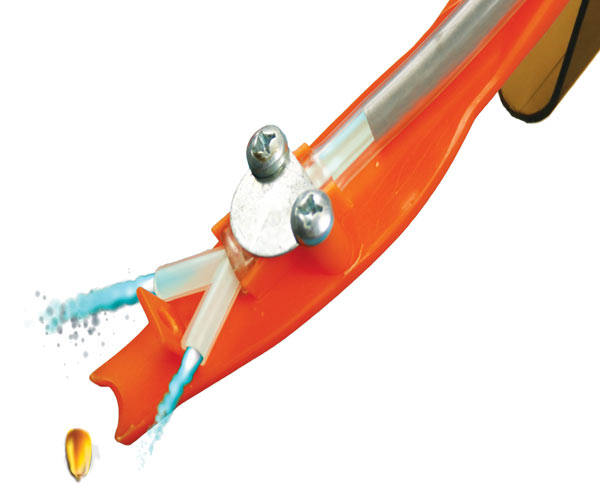
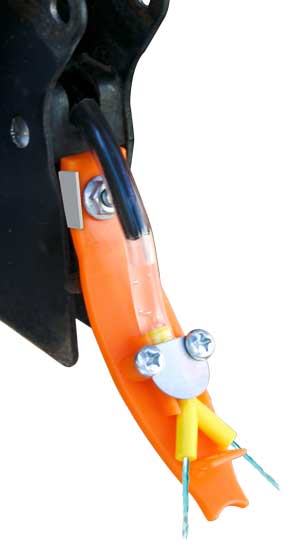
LOW RATE Y
Sometimes when applying less than 5 GPA, one side of the standard Y splitter may plug. We have a micro Y that eliminates this plugging problem, allowing liquid rates as low as 1 GPA.
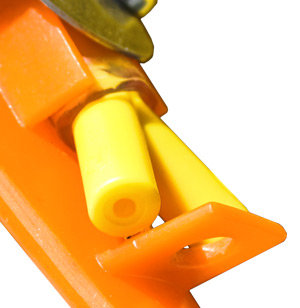
This new for 2018 yellow Y has half size holes for placing lower volumes of fertilizer on the side walls.
- Hole size reduced by half
- With standard clear Y splitter, you must apply at least 6+ GPA to prevent plugging on one side
- With micro Y, you can put on as low as 1 GPA and both sides will remain open
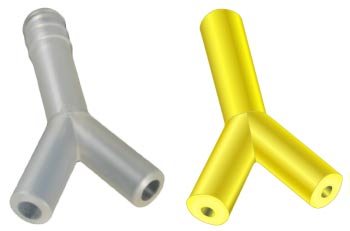
Benefits of the Y-Not
Seed germination can be damaged when starter fertilizers or those with sulfur or high nitrogen content are placed directly on the seed (in drier or sandy soils).
Soil types play a large role in what method of fertilizer application should be used (direct or split), so we would advise you to talk to your fertilizer dealer or crop consultant. Many farmers with higher rainfall and/or heavier textured soils sometimes put fertilizer such as 10-34-0 or 9-18-9 on with the Y-Not Split-It.
Using the Y-Not Split-It with the Rebounder will give you a barrier of soil between the seed and the fertilizer. This little insurance could mean a lot to your peace of mind as well as higher yields. Many farmers and fertilizer/seed dealers are looking at this with great interest as a simple and beneficial way to give the crop an added boost in its earliest stage of development.
Ear size and bushels are determined early on in the developmental cycle, so you can see how this could be beneficial to the long term outcome. Even soybean yields can be increased with in-furrow fertilizer application. As much as five bushels per acre have been reported from farmers using the Rebounder with the Y-Not Split-It.
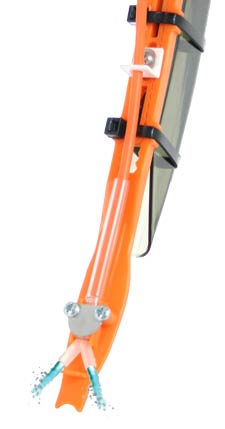
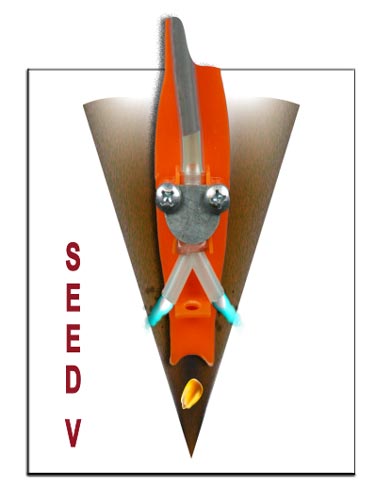
- Fertilizes sidewalls of seed V
- Ensures that seeds will not be drenched
- Apply up to 10 gallon in-furrow
- Takes less than 5 minutes to install
Bullet Check Valves

Bullet check valves are optional with the Y-Not. They allow pressure and stop the flow of liquid directly above the Y-Not when the fertilizer pump is shut off.
If using bullet check valves, you may want to install the Y-Not kit shown in this picture.
Important points to remember when using bullet check valves:
- All fertilizer must be filtered before it goes into any check valve. Filtering will prevent the check valve from sticking open or closed.
- All systems must be thoroughly washed and/or blown out at the end of the planting season to prevent crystals in the lines. This will help prevent the check valves from becoming plugged for next planting season.
Testimonials
STRAIGHT SHOT™
In-Furrow Fertilizer Fitting for the Rebounder
About the Straight Shot
As the Rebounder places the seeds in the bottom of the furrow, the Straight Shot places fertilizer or inoculants directly on the seed from under the Rebounder.
It works very well on planter or drills that have press wheels that run on or in the furrow.
The Straight Shot will keep the fertilizer from caking up on the press wheel. It also prevents mud build up on the press tires and reduces debris getting caught up under it.
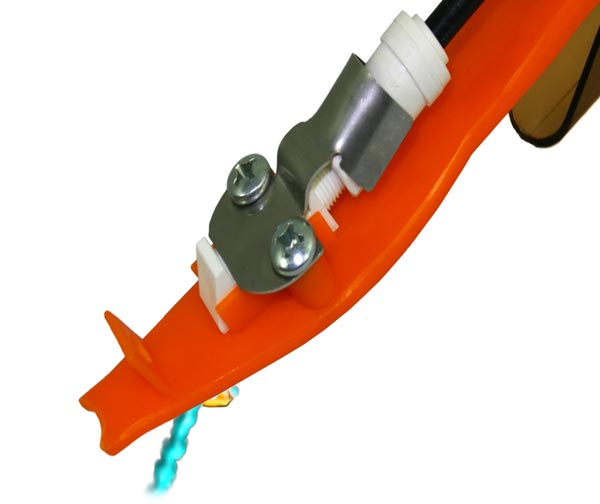
Benefits of the Straight Shot
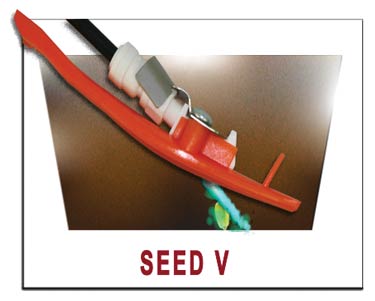
- Fertilizer, insecticide, or inoculants are applied with the seed from under the Rebounder
- Keeps liquid off wheels and discs
- Eliminates mud build up on press wheels
- Mounts in same spot as the “y” from the Y-Not Split-It Kit
- Lower profile design
- Secured in place with metal plate and screws
- Takes less than 5 minutes to install
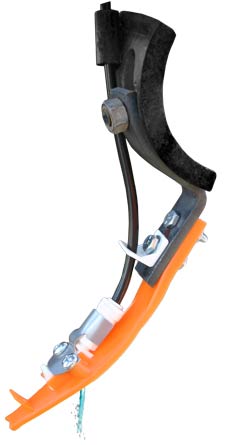
Bullet Check Valves

Bullet check valves are optional with the Straight Shot. They allow pressure and stop the flow of liquid directly above the Straight Shot when the fertilizer pump is shut off.
If using bullet check valves, you may want to install the Straight Shot kit shown in this picture.
Important points to remember when using bullet check valves:
- All fertilizer must be filtered before it goes into any check valve. Filtering will prevent the check valve from sticking open or closed.
- All systems must be thoroughly washed and/or blown out at the end of the planting season to prevent crystals in the lines. This will help prevent the check valves from becoming plugged for next planting season.
Straight Shot VS Hose Holder
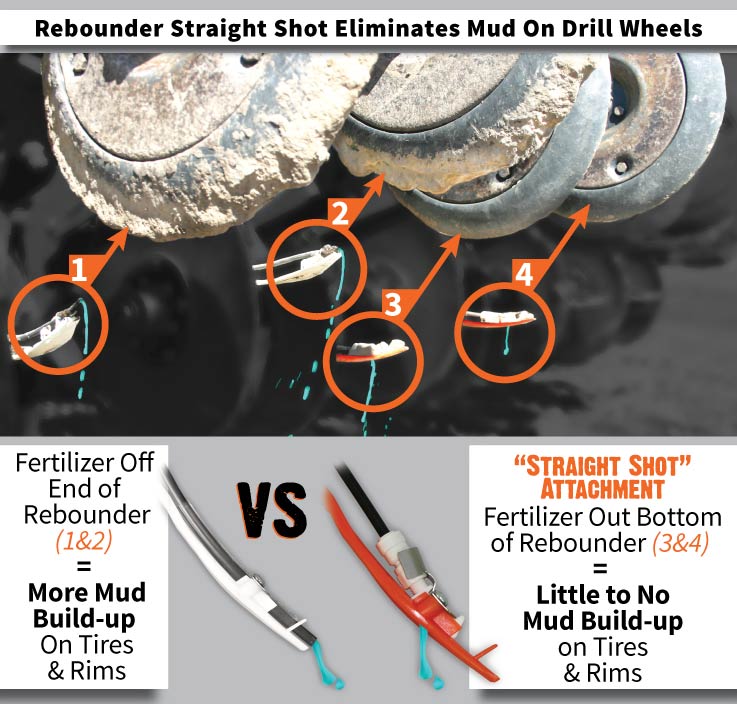
Testimonials
HOSE HOLDER™
In-Furrow Fertilizer Fitting for the Rebounder
About the Hose Holder
The Hose Holder, attached to the top of the Rebounder, distributes the liquid out front and on top of the seed.
This method mixes a little soil in with the fertilizer.
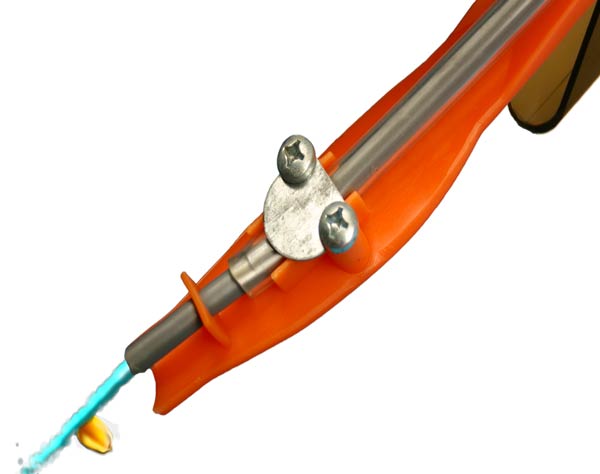
Benefits of the Hose Holder
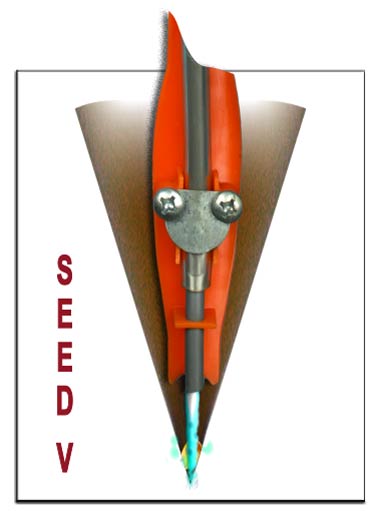
- Places liquids above and on the seed
- Keeps liquid off discs and planter
- Distributes liquids evenly in-furrow
- Hose is secured with molded-in tab
- Mounts in same spot as the “y” from the Y-Not Split-It Kit
JOHN DEERE 750-1990 DRILLS
In-Furrow Fertilizer Fitting for the Rebounder
The flapper John Deere installs on their drills is a flat thin piece of plastic that runs to the top of the furrow, so when the press wheel comes along and the seeds are all over in the seed trench the press wheel will press them in the side walls as well as the bottom of the seed V. This causes uneven depth placement of seeds and can also cause uneven emergence of plants.
The Rebounder on John Deere 750-1990 drills works very well because of its concave design that will direct all the seeds to the bottom of the furrow, so when the press wheel comes along it will press them in the bottom of the furrow. The Rebounder is 3-4 times heavier than the little flapper John Deere installs on the drills, thus giving it high wear qualities.
The Rebounder eliminates the uneven depth placement and thus enhances a more uniform emergence. The John Deere Drill Rebounder is only $10 per row and they pay for themselves on a 15′ drill in less than 150 acres of planting.
John Deere didn’t leave a good place on their drills to put starter fertilizer in-furrow, so we come up with several attachments to do so. These options work well with the Rebounder.
Tube Over the Press Wheel
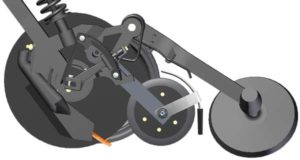 This is one of our earlier fertilizer tube attachments that we have put together for the John Deere 750-1990 No-Till Drills. As drills improved from the early 750s to the present-day 1990 drills, changes have been made.
This is one of our earlier fertilizer tube attachments that we have put together for the John Deere 750-1990 No-Till Drills. As drills improved from the early 750s to the present-day 1990 drills, changes have been made.
Early on we tried to run a stainless tube down the back of the seed boot and drop the fertilizer into the seed V ahead of the press wheel but the fertilizer would splash back on the press wheel, coating it and bearings with fertilizer. Then we added the Rebounder to the seed boot, replacing the seed flap that John Deere had. The seed flap didn’t have a concave design like the Rebounder does nor was it as thick as the Rebounder.
By putting the Rebounder on in place of the seed flap we helped put all the seeds in the bottom of the furrow as well as created a tab on top of the Rebounder to hold the fertilizer tube in the furrow. This helped keep fertilizer off the bearings of the press wheel, but it still let fertilizer build up on the press wheel tire itself. The press wheel would also rest on the Rebounder when the drill was in the up position and break the Rebounder off.
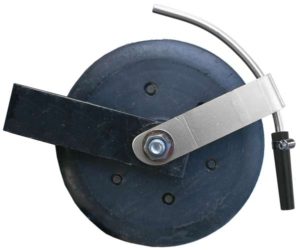 This prompted us to make a tube to go behind the press wheel tire. This worked fine as long as there wasn’t any trash involved. Where ever there was trash such as cobs and stalks they would get caught between the press wheel and the stainless tube and stop the wheel from turning.
This prompted us to make a tube to go behind the press wheel tire. This worked fine as long as there wasn’t any trash involved. Where ever there was trash such as cobs and stalks they would get caught between the press wheel and the stainless tube and stop the wheel from turning.
Other problems with the stainless tube over the press wheel were the cast closing wheel bracket would sometimes come down and bend the tube and bracket that went over the press wheel. This would happen if the farmer went over too steep of terraces or through too deep a ditch in the field.
With several years under our belt and working with farmers we have modified the fertilizer tube over the press wheel to work and perform much better. Our new stainless steel fertilizer tube is easy to install and runs over and behind 9″ John Deere press wheels.
We also recently added a new heavy duty rubber boot to the bottom of the fertilizer tube. This boot is specially made for our fertilizer tubes, designed to immediately snap back into place after hitting trash. It works better than the drag hose previously used. The rubber boot also helps eliminate fertilizer on the row unit.

BENEFITS OF THE STAINLESS FERTILIZER TUBE OVER THE PRESS WHEEL
- Places fertilizer behind the press wheel for a cleaner drill
- Rebounder’s concave design places all the seeds in the bottom of furrow
- The press wheel presses seeds in before fertilizer is placed above the seed
- Bracket models fit the 9″ (SDX & JD type) press wheel
BENEFITS OF THE 9″ PRESS WHEEL
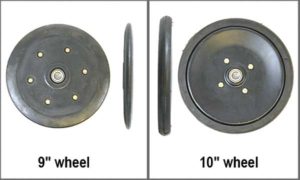 All the older John Deere Drills such as the 750 have 10″ press wheels and all newer drills like the 1890 and 1990s have 9″ press wheels. We recommend switching out the 10″ press wheel on older drills for 9″ press wheels.
All the older John Deere Drills such as the 750 have 10″ press wheels and all newer drills like the 1890 and 1990s have 9″ press wheels. We recommend switching out the 10″ press wheel on older drills for 9″ press wheels.
If you decide to keep the 10″ press wheel you will need a press wheel stop to prevent damage to the rebounder and the bolts on the press wheel.
The 10″ press wheel is larger, thus hitting the rebounder. This is why you need a press wheel stop.
The 9″ press wheel is by far better to use than the 10″ press wheel because of its shape for putting seeds in the bottom of the furrow better. The 9″ press wheel has more of a V type shape that will let it conform to the shape of the seed boot and single disc opener on the drill.
The 10″ press wheel is more rounded on the bottom and doesn’t fit the shape of the seed V as well. This is why all new John Deere drills have the 9″ press wheel as standard equipment. Your local dealer can supply these 9″ press wheels or you can order the 9″ press wheels from us at minimal cost.
The 9″ Press Wheel:
- Smaller and narrower
- Fits seed furrow better (shaped like the seed V)
- Works well with the Rebounder, which eliminates seeds from getting pressed into the sidewalls
- The Rebounder’s concave design funnels seeds to the bottom of the furrow and the 9″ wheel presses them in
- Eliminates need for press wheel stops
- Keeps stainless steel tube from coming in contact with the cast closing wheel arm
Chad's Tube
This is one of several designed attachments that Schaffert Mfg. Co. sells to place starter fertilizer in the furrow of most John Deere model 1560-1990 No-Till Drills. (NOTE: JD 750 Drills require a different mounted tube. Please specify when ordering if you have a JD 750 Drill.)
We call this “Chad’s Tube” because it was designed by a farmer named Chad who plants crops with a John Deere No-Till Drill. “Designed by a farmer for farmers.” It is probably one of the better ways to put starter in furrow with the seed.
Chad’s Tube works very well with the Rebounder on these models of drills because the Rebounder has a concave design to put all the seeds in the bottom of the furrow along with the fertilizer from Chad’s Tube. The Rebounder takes the place of the John Deere seed flap that sometimes leaves seeds on the side walls or out of the seed trench, thus making fertilizer placement less effective.
Farmers have found by using the Rebounder over the John Deere seed flap that they can back off on higher cost seeding rates because the Rebounder gives them uniform depth placement of all the seeds, and that in turn gives them larger numbers of plants germinating and more uniform emergence. In tests conducted with soybeans where farmers have decreased their seeding rates from 220,000 seeds down to 150,000 seeds per acre their yields haven’t dropped by using the Rebounder and starter fertilizer.
By cutting the seeding rate by almost 1/3 can be a substantial savings in seed costs and enough to pay for the Rebounder and Chad’s Tube in a small amount of acres planted. This makes the drill more like a planter.
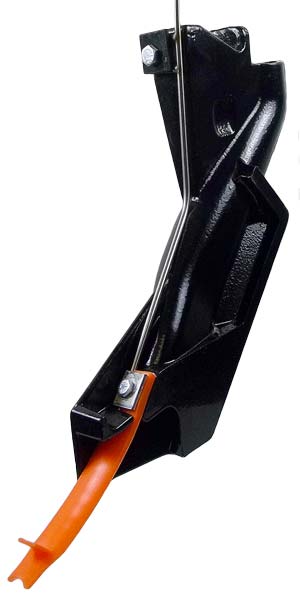
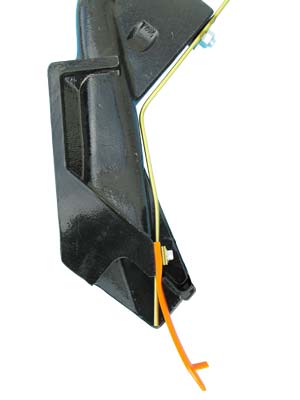
BENEFITS OF CHAD’S TUBE
- Chad’s Tube and the Rebounder are protected from trash by being mounted to the back of the seed boot
- Places starter inside the boot and below the Rebounder with the seed
- Rebounder also keeps fertilizer from Chad’s Tube from coming in contact with the press wheel that runs in the seed V
- Chad’s small tube and the compact design of the Rebounder let both run without interference with the press wheel
- Ease of installation with one bolt to the Rebounder and the other to the top of the seed boot
- Chad’s Tube is made of stainless steel for corrosion protection
- Chad’s Tube and the Rebounder allow the press wheel to press seeds in below the starter
The Fin
The Fin, Fertilizer and Seed Spacer, is the cleanest method to apply in-furrow liquid starter fertilizer with single disc drill openers.
The 3/4″ wide Fin, made of UHMW (Ultra High Molecular Weight) plastic to ensure long wear life, replaces the traditional 1″ wide seed firming wheel. The narrower Fin provides more consistent seed depth. In moist or wet seeding conditions, it eliminates lifting of seed from the furrow by the rolling wheel.
The Fin places liquid fertilizer at the deepest point of the furrow. Regardless if the Fin’s are brand new or have worn to 50%, the patented design keeps the delivery point deep in the furrow. This means your equipment stays clean. Compared to traditional stainless steel tube delivery methods, splatter on the drill is virtually eliminated.
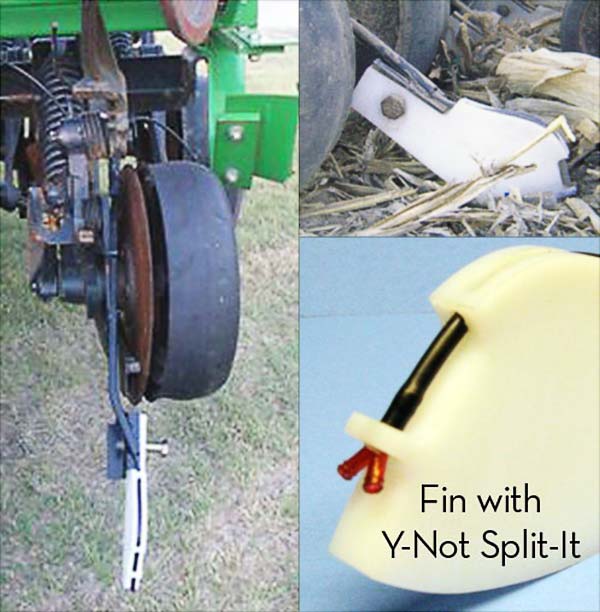
IN-FURROW OPTIONAL FERTILIZER FITTINGS
for Rebounder Seed Covers
Plants require 14 essential nutrients for healthy growth. The absence of any one nutrient in the soil can limit plant growth, even when all other plant nutrients are present in adequate amounts. The three micro-nutrients that are most essential for food production and quality are nitrogen, phosphorus and potassium.
Fertilizer placement in relation to the seed is the key to successful plant growth. Soil types play a large role in what method of fertilizer application should be used (direct or split), so we recommend you consult with your agronomist on which fitting will work best for your agricultural program.
About Our In-Furrow Fittings
Each Rebounder has the option of allowing liquid fertilizer or chemical to be applied in various locations to accommodate your specific needs. Whether you want to split the fertilizer or place it directly on the seed, we have many options for you to choose from.
Ear size and bushels are determined early on in the developmental cycle. Adding fertilizer in-furrow is a simple way to give the crop an added boost in its earliest stage of development.
Even soybean yields can be increased with in-furrow fertilizer application. As much as five bushels per acre have been reported from farmers using in-furrow fertilizer fittings with the Rebounder.
In-Furrow Options
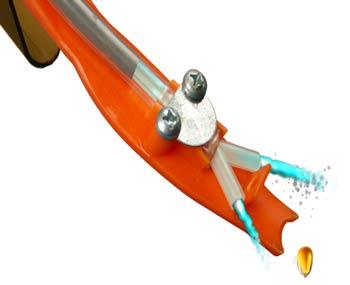
Y-NOT SPLIT-IT™
- Fertilizes sidewalls of seed V
- Ensures that the seeds won’t be drenched
- Apply up to 10 gallons per acre in furrow
- Less than 5 minutes to install
- Optional Bullet Check Valve – stops the flow of liquid at end of Y when pump is shut off
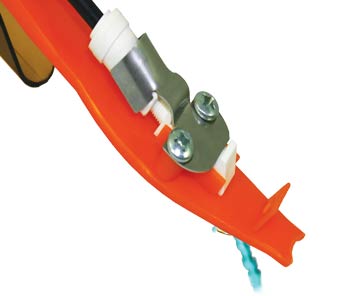
STRAIGHT SHOT™
- Places liquid directly on the seed from under the Rebounder
- Lower profile design
- Keeps liquid off wheels and discs
- Secured with metal plate
- Works with planters and drills
- Optional Bullet Check Valve – stops the flow of liquid at end of Y when pump is shut off
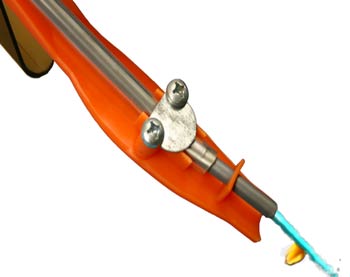
HOSE HOLDER™
- Places liquids above and on the seed
- Keeps liquid off discs and planter
- Hose is secured with molded-in tab
- Distributes liquids evenly in furrow
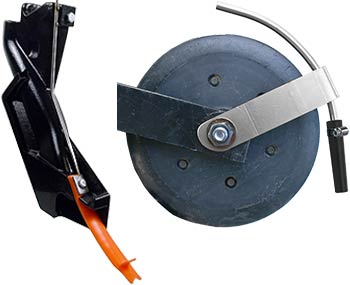
FITTINGS FOR JOHN DEERE 750-1990 DRILLS
Multiple options made specifically for John Deere 750-1990 drills include:
- Chad’s Tube
- Stainless steel tube that runs over the 9″ press wheel
- The Fin
- JD Drill Rebounder
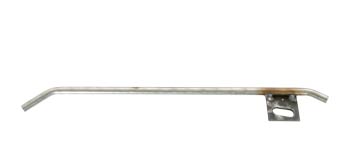
STAINLESS STEEL TUBES
- Easy installation
- Effective liquid placement
- Durable, rust free stainless steel
- Works with planters and drills
- Great for starter application
- Works with Rebounders
GRANULAR APPLICATION
- Applies granular in-furrow


